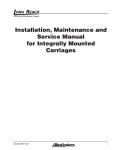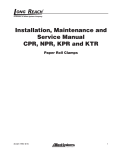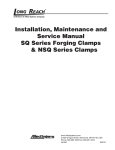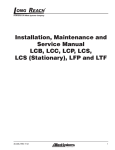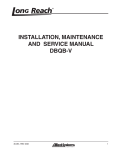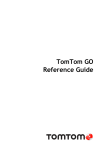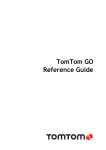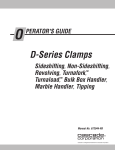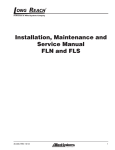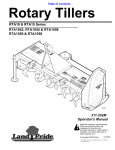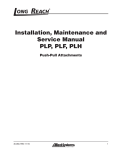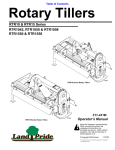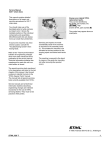Download Installation, Maintenance and Service Manual LC and LTF
Transcript
Installation, Maintenance and Service Manual LC and LTF Bale Clamps, Drum Clamps, Pallet Fork Clamps, Bar Arm Clamps, Load Inverters, and Turning Fork Clamps 45-006, REV. 10/15 1 TABLE OF CONTENTS SECTION 1 NAMEPLATE LOCATION................ 3 SECTION 5 SERVICE PROCEDURE............... 18 SECTION 2 MODEL INFORMATION.................. 4 5.1 Attachment Removal.............................18 SECTION 3 SAFETY SUMMARY....................... 5 5.2 Arm Removal.........................................19 3.1 Safety Information....................................5 5.3 Arm Installation......................................19 3.2 Safety Regulations...................................5 3.3 Safety Symbols........................................5 5.4 Arm Retention Pin (folding bale arms only).......................................................19 3.4 Labeling...................................................5 5.5 Cylinder Removal..................................21 3.5 Training....................................................5 5.6 Cylinder Disassembly............................21 3.6 Personnel Safety......................................6 5.7 Cylinder Inspection................................22 3.7 Pre-start Checks......................................6 5.8 Cylinder Assembly.................................22 3.8 Operation Warnings.................................6 5.9 Cylinder Installation...............................23 3.9 Hydraulic Hazards ..................................7 5.10 Hydraulic Valve Removal.....................23 3.10 Electrical Hazards..................................7 5.11 Hydraulic Valve Installation..................23 3.11 Maintenance Warnings..........................7 5.12 Repair-In-Place Wear Strip..................24 3.12 Load Handling.......................................8 5.13 Camber Adjustment For .Articulating Arm Carton Clamps....................................25 3.13 Load Positioning..................................11 3.14 Operator’s Controls .............................11 3.15 Clamp Open Control............................12 5.14 Toe Adjustment For Articulating Arm Carton Clamps....................................26 3.16 Industry Standards..............................12 5.15 Force Adjustment for Adjust-A-Force Clamps................................................26 SECTION 4 INSTALLATION PROCEDURE...... 14 5.16 Rotating Contact Pads.........................28 4.1 Truck Requirements...............................14 5.17 Pinion/Ring Gear and Bearing.............28 4.2 Attachment Installation..........................14 5.18 Oil-Filled Gearboxes............................29 4.3 Hydraulic Connections, Sideshifting/ Clamping Units......................................16 5.19 Grease-Filled Gearboxes ....................32 4.4 Hydraulic Connections, Rotating/Clamping Units......................................................17 5.21 Motor Assembly...................................37 5.20 Motor Disassembly..............................35 SECTION 6 MAINTENANCE SCHEDULE........ 41 6.1 Schedule................................................41 6.2 Schedule, Stationary Load Inverter.......41 6.3 Torque Specifications.............................42 2 45-006, REV. 10/15 SECTION 1 NAMEPLATE LOCATION NOTICE When you receive your attachment, locate the Long Reach nameplate (upper left corner on the body). Record the information from the nameplate, along with the date received, at the bottom of this page. If the nameplate is missing, look for the serial number stamped directly into the metal at the nameplate location and consult the factory for details. Date received: - 45-006, REV. 10/15 - Approximate nameplate location 3 SECTION 2 MODEL INFORMATION Each attachment is identified by a model number and a serial number located on the nameplate attached to the unit prior to shipment. Long Reach’s model numbers are designed to describe how an attachment is equipped. The guide below gives a sample of information represented in a multi-digit model number. See the sales description on your invoice for serial number-specific information for your attachment. Always include model and serial number when ordering parts or requesting service information. LCS Series Model Number: L C S 5 0 CAPACITY 50 = 5,000 lbs @ 24" load center SERIES LCS = Pallet fork clamp LCB = Bale clamp LCC = Carton clamp LTF = Turning fork N S F D ARM TYPE F = Weld-on pallet fork arms 4 2 FORK DIMENSIONS (width x useable fork length) 5" wide x 42" long FORK THICKNESS B = 1.5" C = 1.75" D = 2.0" E = 2.25" K = 3.5" FUNCTION NS = non rotating, sideshifting NN = Non sideshifting RN = 360 rotating, non sideshifting RP = 360 rotating, non sideshifting, flow divider 4 5 S T D 0 B Q MOUNTING ANGLE 0 = 0 degree MOUNTING AN = Class II, bolt-on AQ = Class II, quick disconnect BN = Class III, bolt-on BQ = Class III, quick disconnect DN = Class II/III dual OPTION STD = standard unit, no options 45-006, REV. 10/15 SECTION 3 SAFETY SUMMARY 3.1 Safety Information CAUTION Safety is Everyone’s Responsibility Whether you are new on the job or a seasoned veteran, these safety tips may prevent injury to you, to others, or to the materials you are handling. Always be alert, watch out for others, and follow these suggestions: Attachments handle material, not people. Safety starts with common sense, good judgement, properly maintained equipment, careful operation, and properly trained operators. Indicates a hazardous situation which, if not avoided, could result in minor or moderate injury, or equipment damage or void the machine warranty. Carefully read the message that follows to prevent minor or moderate injury. NOTICE The safety instructions and warnings, as documented in this manual and shipped with the machine, provide the most reliable procedures for the safe operation and maintenance of your Long Reach attachment. It’s your responsibility to see that they are carried out. Describes information that is useful but not safety related. 3.2 Safety Regulations Multiple hazards. Know your company’s safety rules. Some companies have site-specific directions and procedures. The methods outlined in your operator’s manual provide a basis for safe operation of the machine. Because of special conditions, your company’s material handling procedures may be somewhat different from those shown in this manual. Ignoring safety warnings may cause equipment damage, personal injury or death. 3.3 Safety Symbols The following terms define the various precautions and notices: DANGER Indicates a hazardous situation which, if not avoided, will result in death or serious injury. Carefully read the message that follows to prevent serious injury or death. WARNING Indicates a hazardous situation which, if not avoided, could result in death or serious injury. Carefully read the message that follows to prevent serious injury or death. 45-006, REV. 10/15 WARNING All possible safety hazards cannot be foreseen and included in this manual. The operator must always be alert to possible hazards that could endanger personnel or damage the equipment. 3.4 Labeling • Change capacity, operation, and maintenance instruction plates, tags, or decals when a forklift truck is equipped with an attachment. If the truck is equipped with front-end attachments other than factory installed attachments, truck must be marked to identify the attachments and show the approximate weight of the truck and attachment combination at maximum elevation with load laterally centered. 3.5 Training • Make sure all operators are trained in the fork and attachment adaptation, operation, and use limitations. Retrain an operator if a new attachment is added to the forklift. Consult the operator’s manual for instructions on how to use the new equipment. • Know the mechanical limitations of your forklift. 5 • Modifications or additions that affect capacity or safe operation must have prior written approval from the forklift truck manufacturer. Capacity, operation, and maintenance instruction plates, tags, or decals shall be changed accordingly. (Figure 3-3) • Never leave an attachment or load in an elevated position. • Never use free rigging for a below-the-forks lift. It could affect the capacity and safe operation of a lift truck. • Always operate an attachment from the operator’s seat, never while standing next to the lift truck. • Never reach through the mast of the truck. Keep all parts of the body within the driver’s compartment. 3.6 Personnel Safety • Do not allow riders on the truck at any time. • When removing or installing dismountable attachments always keep hands and feet free from dangerous positions or pinch points. Never leave a dismounted attachment in a dangerous position. • Always use reverse when carrying a load that impedes full vision. Watch for pedestrians when transporting. • Keep hands, feet, long hair and clothing away from power-driven parts. Do not wear loose fitting clothing or jewelry while performing maintenance and lubrication in these areas. • Never jump on or off the machine. • Never stand on top of material being raised, lowered, or transported. (Figure 3-1) • Always use personal protective equipment (PPE) appropriate to the situation. 3.7 Pre-start Checks • Check your equipment before you operate it. If anything looks wrong, unusual or different, report it before using the attachment. • Do not operate this machine if you know of malfunctions, missing parts, and/or mis-adjustments. These situations can cause or contribute to an accident or damage to the machine. Stop the machine immediately if problems arise after starting. • Check to make sure the attachment on your truck is the same as on the truck capacity plate. Figure 3-1 • Check for hydraulic leaks and cracked hoses or fittings. Check the hydraulic oil level in the lift truck hydraulic reservoir. • All electrical cables and connectors must be in good condition. Use caution in wet weather to avoid danger from electrical shock. Figure 3-2 • Always check the attachment for proper fit and engagement of the truck carriage. 3.8 Operation Warnings • You must be trained to operate this equipment prior to operation. Be extremely careful if you do not normally operate this machine. Reorient yourself to the machine before starting, then proceed slowly. Figure 3-3 • Never use the attachment or its load to support a man-carrying device. • Never allow anyone under a load or under the carriage. (Figure 3-2) • Always operate an attachment from the driver’s seat. • Always lower the attachment if you need to leave the lift truck. A lift truck supporting a load requires your full attention. • Never stand in front of or beside an attachment that is being operated. Never allow another person to approach an attachment that is being operated. 6 45-006, REV. 10/15 3.9 Hydraulic Hazards DANGER Injection hazard. Infection and gangrene will result when hydraulic oil penetrates the skin. See a doctor immediately to prevent loss of limb or death. Use a piece of cardboard to check for hydraulic leaks. • Wear personal protective equipment, such as gloves and safety glasses, whenever servicing or checking a hydraulic system. • Assume that all hydraulic hoses and components are pressurized. Relieve all hydraulic pressure before disconnecting any hydraulic line. • Never try to stop or check for a hydraulic leak with any part of your body; use a piece of cardboard to check for hydraulic leaks. 3.10 Electrical Hazards WARNING Electrocution hazard. Contact with energized equipment may result in injury or death and will damage equipment. Remain at least 25 feet from high voltage electrical wires. • All electrical cables and connectors must be in good condition (free of corrosion, damage, etc). Use caution in wet weather to avoid danger from electrical shock. Never attempt electrical testing or repair while standing in water. • Do not wear electrically conductive jewelry, clothing, or other items while working on the electrical system. 3.11 Maintenance Warnings Maintenance, lubrication and repair of this machine can be dangerous unless performed properly. You must have the necessary skills and information, proper tools and equipment. Work in a method that is safe, correct, and meets your company’s requirements. 45-006, REV. 10/15 • Do not attempt to make adjustments, or perform maintenance or service unless you are authorized and qualified to do so. • Include attachments in a scheduled maintenance and inspection program. Tailor inspection steps to the attachment. • Unless specified in service procedures, never attempt maintenance or lubrication procedures while the machine is moving or the engine is running. • Always perform all maintenance and lubrication procedures with the machine on level ground, parked away from traffic lanes. NOTICE Local laws and regulations may require that additional safety measures be taken. • Never rely on the hydraulic system to support any part of the machine during maintenance or lubrication. Never stand under a component that is supported only by the hydraulics. Make sure it is resting on its mechanical stops or appropriate safety stands. • Use caution when working around hot fluids. Always allow lubricating and hydraulic oils to cool before draining. Burns can be severe. • Use extreme caution when using compressed air to blow parts dry. The pressure should not exceed 30 psi (208 kPa) at the nozzle. Never use compressed air on yourself. Air pressure penetrating your skin can be fatal. WARNING Suffocation hazard. Engine exhaust fumes can cause death. Remove the exhaust fumes from the area with an exhaust pipe extension, or use ventilation fans and open shop doors to provide adequate ventilation. • Before disconnecting hydraulic lines, be sure to lower all loads and relieve all hydraulic pressure. The load could fall on you, or escaping hydraulic oil could cause severe personal injury. • Prevent personal injury or equipment damage by using a lifting device with a lifting capacity greater than twice the weight of any equipment to be lifted. 7 3.12 Load Handling • Treat an unloaded forklift with an attachment as partially loaded. • See the following illustrations for general information about load handling. Always follow your company’s safety rules, directions and procedures. Your company’s material handling procedures may be somewhat different from those shown in this manual. Carton and Pallet Clamps Pallet is the same width as the load Pallet is wider than the load Load is not stacked neatly Too much clamping force on the load Figure 3-4 Bale and Multi-Purpose Clamps Tilt mast back 3˚ to 4˚ for travel A Mast in vertical position, arms parallel to the floor. Load is centered, not sideshifted B Move truck forward, position load against backrest. C Align the bottom of the load with the bottom of the pad edges. Clamp is too high on load Lift load 12 in. (30 cm) Load clamped crookedly Travel with mast tilted forward Figure 3-5 8 45-006, REV. 10/15 Drum Clamps Tilt mast back 3˚ to 4˚ for travel A Drums are all the same size, all squarely aligned. Contact pads positioned under upper chines B Use the correct clamping force. Drums are not squarely aligned. Lift load 12 in. (30 cm) Drums are not the same size. Load clamped too low. Figure 3-6 Fork Clamps A Mast in vertical position, arms parallel to the floor. Tilt mast back 3˚ to 4˚ for travel Transport load centered, not sideshifted B Move truck forward, position load against forks. Lift load 12 in. (30 cm) Travel with mast tilted forward Position forks to the pallet’s outside edges 45-006, REV. 10/15 Forks in center of pallet Figure 3-7 9 General Load Handling Limit sideshifting with raised load. Backrest Center the load before lifting and traveling. Check for load slippage. Limit truck movement with raised load. Position the load’s center of gravity as close as possible to the center of rotation to minimize lateral offset, reduce torque requirements and increase truck stability. Make sure the load is stable before lifting or traveling. Unclamped loads on top must be stable and safely arranged before lifting and traveling. A backrest is required (see OSHA 1910.178 and ANSI B56.1, page 14) where the load could fall backwards into the mast. Load Center of Gravity Center of Rotation Minimize Lateral Offset Figure 3-8 10 45-006, REV. 10/15 3.13 Load Positioning Equipment overload hazard. Injury or equipment damage may result if the capacity of the truck and attachment combined are less than the attachment capacity. Consult truck nameplate for truck capacity with an attachment installed. • Never overload the attachment. Refer to the attachment nameplate for the rated capacity of the attachment. Refer to the truck nameplate for the maximum net working capacity of the truck/attachment combination. Never use a load to support or move another object. Doing so can easily exceed the holding capacity of the attachment. • Be accurate in load placement. It’s important to know what the load will do when it’s released. • Always carry loads as close to the floor as possible, consistent with the surface being traversed. Scraping or bumping the floor surface with the load or the attachment can severely damage the attachment and cause product damage. The mast should be tilted back. • Always keep the load positioned as close as possible to the horizontal center of the lift truck. • Always back down ramps or inclines. Driving forward down a ramp or incline with a clamped load will lessen the stability of the truck. (Figure 3-9) • Always check loads to be handled. Correct loads that are broken, unbalanced, loose, or too heavy. • Never lift, lower, side shift, pivot, rotate, or tilt loads while traveling. Repositioning loads while traveling affects the stability of the truck and may impede vision or clearances. Figure 3-9 • Do not use an attachment to open or close boxcar doors. Doing so can severely damage the attachment and cause loss of warranty. Damage to clamp arms may result in product damage. • Do not cross dock boards or dock levelers with the attachment or carriage fully lowered. Ramming the front or rear of the attachment against a dock board can cause severe damage. • Do not carry loose items or unsupported loads on top of a clamped load. • Limit lift truck movement to a minimum when high stacking. Limit sideshift movement to a minimum when high stacking. • Never use chains, cables, or other devices in conjunction with an attachment for load handling. • Never clamp loads other than what the attachment was designed to handle. • Always carry cylindrically shaped loads in the vertical position, not the horizontal. • Always clamp loads with the contact pads, if applicable, not the arm or arm base. • Never rotate a load that is off center to the centerline of rotation. Severe damage to the rotator could result. • Always ensure that the load is the same width as the pallet and neatly stacked when using a carton clamp. • Always be observant when high stacking. Look for poorly stacked loads, overhead obstacles, broken cartons, or damaged products in the stack. • Travel slowly around corners. Sound horn on blind corners. Be careful of tail swing and overhead clearances. Watch in all directions. Avoid sudden stops. 3.14 Operator’s Controls Some lift trucks are equipped with a single lever to control both hoist and tilt functions, others have separate levers for each function. Refer to your lift truck manual for more information. For clarity, the direction of arm movement is shown on the control handle. To move the arms in the direction shown, pull the handle towards the operator. To move the arms in the opposite direction, the push the handle away from the operator. (Figure 3-10) 45-006, REV. 10/15 11 3.16 Industry Standards ANSI/ITSDF B56.1-2009 is the published sequence and direction standard for lever- and hand-type controls. Clamp Push/pull Fork position Rotate Sideshift Figure 3-10 Operator controls Lifting speed is controlled by the speed of the engine and the position of the control lever. Engine speed has no effect on lowering speed. Before going on the job, shift the truck control levers one way and then the other to determine which direction the attachment moves when the levers are shifted. Make sure the attachment moves smoothly throughout its travel, without binding or pinching hoses. The chart on the following page shows industry standards. Your equipment may be different. If you do not routinely operate this equipment, refresher training is recommended. You must reacquaint yourself with this manual and the equipment before starting, and then proceed slowly. Special controls such as automatic devices should be identified, preferably according to the recommendations in Figure 3-12. When a function is controlled by a pair of push buttons, they should operate in the same sense as the lever controls. For example, pushing a button located to the rear (relative to the operator’s position) should serve the same function as moving a control lever to the rear. Equipment damage hazard. Injury or equipment damage may result if the attachment does NOT operate smoothly. Do not take malfunctioning equipment on the job. Check with your supervisor about needed repairs. 3.15 Clamp Open Control For all lift trucks with a load bearing clamp (paper roll clamp, carton clamp, etc.), ANSI/ITSDF B56.1, Section 7.25.7 requires the driver to make two distinct motions before opening or releasing the clamp. For example, you must press a switch and then move a lever to unclamp the load. This requirement applies to new and used attachments being mounted on new trucks shipping from the factory after October 7, 2010, and is a recommended feature to be installed on dealer orders and existing applications. 12 45-006, REV. 10/15 Direction of motion Function Load Hoist Reach Tilt Sideshift Push-pull Rotate, lateral Rotate, longitude Load stabilizer Swing Slope Fork position Trip Grip Truck stabilizer Clamp Operator's hand on control handle, facing the load* Up Rearward or up Down Forward or down Retract Rearward or up** Extend Forward or down Rearward Rearward or up** Forward Forward or down Right Rearward or up Left Forward or down Rearward Rearward or up** Forward Forward or down Clockwise Rearward or up Counterclockwise Forward or down Rearward Rearward or up Forward Forward or down Down Rearward or up Up Forward or down Right Rearward or up Left Forward or down Clockwise Rearward or up Counterclockwise Forward or down Together Rearward or up Apart Forward or down Engage Rearward or up Release Forward or down Engage Rearward or up Release Forward or down Raise Rearward or up Lower Forward or down Clamp Rearward or up Release Forward or down * For high lift order picker trucks and center control pallet trucks, predominant motion of the operator's hand when actuating the control handle while facing away from the load. ** The sense of rotation of the control handle is intended to be in the same direction as the desired motion of the mast or load. Figure 3-12 ANSI/ITSDF Sequence of location and direction of motion for lever- or hand-type controls 45-006, REV. 10/15 13 SECTION 4 INSTALLATION PROCEDURE 4.1 Truck Requirements Long Reach attachments have been designed to operate within specific limits. Operating pressures above the recommended maximum may cause damage to the attachment and may void the warranty. Operating pressure specifications for your attachment can be found on the attachment nameplate. (Section 1) Hydraulic flow less than the recommended rates, or the use of small I.D. hoses may reduce operating speed. Higher flow can result in excessive heat buildup, erratic operation and damage to the truck/attachment hydraulic system. Hydraulic flow specifications for your attachment can be found on the attachment nameplate. (Section 1) The dealer and/or the user must provide and install the valving required to meet the recommended hydraulic pressures and flow, or must arrange installation of the required valving at the truck factory. WARNING Equipment overload hazard. Overloading the truck may cause equipment damage. Consult truck nameplate to determine the capacity of the truck and attachment combination, as it may be less than the capacity shown on the attachment alone. 2. Purging can be accomplished by installing a jumper line and operating each hydraulic function (clamp, rotate and side shift if equipped) in each direction for a minimum of 30 seconds. (Figure 4-1) Hoses should be 2300 psi working pressure rated for all attachment functions. The attachment model description, found on your shipped invoice, will state the following truck requirements: flow (gpm), psi, and minimum truck carriage width. 1. The truck carriage must conform to the American National Standard (ANSI) dimensions shown in ANSI/ ITSDF B56.11.4-2013. 2. Make sure the truck carriage is clean, conforms to ANSI recommendations, and the notches are not damaged. 3. The truck hydraulic system must supply to the attachment hydraulic oil that meets the specifications required to operate the attachment properly. Find specifications for your attachment on the attachment nameplate. (Section 1) 4.2 Attachment Installation 1. Prior to connecting the truck hydraulic system to the attachment, the system must be purged through the filtration system.This will eliminate any contamination that might exist in the auxiliary hydraulic system of the truck. 14 To truck To clamp Figure 4-1, Jumper Line 3. Remove the lower bolt-on hooks and, if applicable, make a note of any factory installed shims. Shims are used to create clearance between the hook and carriage. If the attachment is equipped with quick hooks, simply depress the button on the back of the hooks, allowing the slide plate to drop. Removal of the quick hooks is NOT recommended. (Figure 4-2) 45-006, REV. 10/15 Slide Plate Raise slide to secure attachment to truck. Button Body Push button to lower slide. 9. Install the bolt-on lower hooks. Inspect clearance between the carriage and the lower hooks. Adjust the lower hooks for a maximum clearance of 3/32" (see Figure 4-4). 3/32" maximum clearance Figure 4-2, Quick Hook 4. Center the truck behind the attachment and drive toward the attachment with the mast tilted forward approximately 4 degrees. 5. Line up the locking lug (under the hanger plate, if applicable) with the appropriate notch on the truck’s carriage. Check that the bronze sideshifting wear strips are in the proper place, if applicable. 6. Slowly raise the truck carriage completely to engage the top hooks with the truck carriage.Tilt carriage back until the unit is against the carriage bottom fork bar (0 degrees). 7. Inspect for proper engagement of the locking lug in the corresponding notch of the truck’s carriage. Inspect any wear strips, if applicable, to insure they are properly aligned in the top hooks. 8. Weld on the supplemental locking lug that is supplied with the attachment, (two pieces of 1/2" x 1/2" x 2.00" steel included with the attachment) with either E-6011 or E-6013 welding rod, or equivalent, on each side of the truck carriage. (Figure 4-3) YXE4C-307 1/2 x 1/2 x 2.00 steel supplemental locking lug Shim(s) if required Figure 4-4, Lower Hook Clearance 10. If quick hooks are installed, simply raise the slide plate until the button clicks into place. WARNING Equipment failure hazard. The attachment could fall off the truck if the quick hook is not properly installed. Slide plate must click into place. If the slide plate does not click into place because the truck carriage prevents the slide plate from being raised up high enough, install shims between the attachment and the body of the quick hooks. 1/16" clearance Locking lug in notch Figure 4-3, Locking Lug 45-006, REV. 10/15 15 4.3 Hydraulic Connections, Sideshifting/ Clamping Units 2. Inspect installation to ensure hoses are not kinked or pinched between the truck carriage and attachment. 1. Install the lines from the truck’s hydraulics to the attachment 's hydraulics. (Figure 4-5) See the parts documentation for model-specific hydraulic schematics. 3. Operate the attachment continuously for several minutes to determine that all hydraulic connections are secure with no leaks. To truck supply (close) V1 To truck V4 secondary (side shift) V3 4. With the mast in the vertical position, open the attachment arms fully. After this procedure, check that the truck’s hydraulic oil reservoir level is at the recommended level. 5. Before placing the attachment in operation check the following: C1 C2 C3 C4 A. Inspect all hoses and fittings for leaks and routing clearance. Be sure to include clearance of jumper hoses to the mast. To truck supply (open) V2 B. Check the valve and cylinder for leaks. C. Check cotter pins at each end of the cylinder for security. To cylinder base end To cylinder rod end 6. After completing the installation, operate the attachment without a load for several cycles to remove any air in the hydraulic system. Test the attachment with a load to make sure the attachment operates correctly. To cylinder base end To cylinder rod end Figure 4-5, Hydraulic Connection Equipment damage hazard. Equipment damage and loss of performance could result if air is trapped in the hydraulic system. Activate the hydraulic functions several times after hydraulic service has been performed, to bleed trapped air out of the system before returning attachment to service. Rod End Base End Equipment damage hazard. Figure 4-6, Cylinder Connection Equipment damage, performance reduction, personal injury and/or loss of warranty could result if any alterations are made to the original attachment. Consult with factory before altering original equipment. 16 45-006, REV. 10/15 4.4 Hydraulic Connections, Rotating/ Clamping Units 1. Install the lines from the truck’s hydraulics to the attachment 's hydraulics. (Figure 4-8) Refer to your parts manual for model-specific hydraulic schematics and hose routing. 2. Inspect installation to ensure hoses are not kinked or pinched between the truck carriage and attachment. 3. After completing the installation, operate all functions of the attachment, without a load, for several cycles to remove any air in the hydraulic system. Test the attachment with a load to make sure the attachment operates correctly. V2 open V1 close Equipment damage hazard. Equipment damage and loss of performance could result if air is trapped in the hydraulic system. Activate the hydraulic functions several times after hydraulic service has been performed, to bleed trapped air out of the system before returning attachment to service. 4. With the mast in the vertical position, rotate the attachment fully 360°. After this procedure, check that the truck’s hydraulic reservoir oil level is at the recommended level. 5. Before placing the attachment in operation re-inspect all hoses and fittings for leaks and routing clearance. Be sure to include clearance of jumper hoses to the mast. Check cotter pins at each end of the cylinder for security. SS2 left SS1 right Truck connection, clamping circuit upper V2 lower V1 Rear View Truck connection, rotation circuit upper rotate lower rotate Figure 4-7, Cylinder Connection, Rotating Units C1 C4 SS2 left V2 V1 SS1 right C1 C4 Rear View Figure 4-8, Rotation Cylinder Connections Detail 45-006, REV. 10/15 Figure 4-9, Hydraulic Connection, Rotating Units 17 SECTION 5 SERVICE PROCEDURE 5.1 Attachment Removal 1. Position the attachment arms to the width of the unit’s body. WARNING 4. Slightly raise the truck carriage to allow the removal of the bottom mounting hooks. If the attachment is equipped with quick change hooks, simply press the slide plate release button and drop the slide plate down. (Figure 5-2) Slide Plate Crush hazard. Serious injury could result if residual hydraulic pressure causes equipment to drift during service procedures. Cycle the hydraulic circuit as described to relieve all system pressure. 2. Disconnect the hydraulic connection for the attachment positioning at the hydraulic valve, ports V1 and V2 (Figure 5-1). Cap hose ends to prevent contamination and tag for reassembly. 3. Disconnect the side shift connections at ports V3 and V4 (Figure 5-1). Cap hose ends to prevent contamination and tag for reassembly. To truck supply (close) V1 To truck V4 secondary (side shift) V3 C1 C2 C3 C4 To truck supply (open) V2 Raise slide to secure attachment to truck. Button Body Push button to lower slide. Figure 5-2, Quick Change Hook 5. Position the attachment on the edge of a pallet. Lower the attachment so that the lower carriage bar misses the pallet when lowered. Tilt the mast forward to allow the carriage to disengage from the upper mounting hooks and back away. If lowering onto a floor, blocks of wood can be placed under the body of the attachment to raise the rear. 6. To reinstall, follow the installation procedure in Section 4.2. Equipment damage hazard. Equipment damage and loss of performance could result if air is trapped in the hydraulic system. To cylinder base end To cylinder rod end To cylinder base end To cylinder rod end Activate the hydraulic functions several times after hydraulic service has been performed, to bleed trapped air out of the system before returning attachment to service. Figure 5-1, Hydraulic Connection 18 45-006, REV. 10/15 5.2 Arm Removal 1. Extend the arms out past the body. Remove the cotter pin retaining the flush nut. Remove the flush nut. (Figure 5-3) 3. Apply a thin coat of bearing grease to the spherical portion of the nut and concave section of the arm lug. Screw on the flush nut until it stops. Back off the flush nut while lining up the cotter pin hole in the rod with the slot in the flush nut. Clearance between the spacer washer and the arm lug should be 1/16 to 1/8 of an inch or less. Be sure there is some clearance between spacer washer and arm lug. (Figure 5-4) 1/16 to 1/8" Clearance Arm Lug Body Spacer Washer Flush Nut Cotter Pin Cotter Pin Flush Nut Arm Weldment Cylinder Rod End Figure 5-3, Arm 2. Support the cylinder barrel so it remains level when the flush nut is removed from the arm lug. Activate the hydraulics and retract the cylinder rod through the arm lug. Be careful not to catch the spacer washer on another component. 4. Insert the cotter pin and bend to lock into place. 3. Attach a suitable overhead hoist to the arm weldment. Pull the arm assembly out of the body. 5.4 Arm Retention Pin (folding bale arms only) Figure 5-4, Arm Lug Retention pins are used only on folding arm bale clamps. When the arms are folded, arm retention pins can be installed to insure that the arms do not open. It is not necessary to remove the arm assembly to replace wear strips. See the section on repair-in-place wear strip replacement. 5.3 Arm Installation Remove the retention pin from its storage position on top of the machine. (Figure 5-5) The pin is attached with a clevis pin and hair pin to the bracket. Follow the illustrated instruction on Figure 5-6 to remove the pin. Installation is the reverse. 1. Attach a suitable overhead hoist to the arm weldment. Line up the slide bar with the proper channel and slide into body. 2. Activate the hydraulics and extend the cylinder rod out until it is at the arm lug. Insert the spacer washer on the cylinder rod and extend the cylinder through the arm lug until the arm moves. 45-006, REV. 10/15 19 Retention pin in storage position Storage bracket Bolt to bracket here Retention pin in place with arms folded (locked position) Cotter pin holds arm hinge pin Figure 5-5, Arm Retention Pin Storage 3. Rotate and lift out retention pin A 2. Lift out hinge pin 1. Pull cotter pin Figure 5-6, Remove Arm Retention Pin (Folding Bale Arms Only) 20 45-006, REV. 10/15 5.5 Cylinder Removal 1. Extend the arms out past the body. Remove the cylinder rod end cotter pin and flush nut. 3. Use a spanner wrench or similar tool to unscrew the gland cap from the cylinder tube. (Figure 5-8) 2. Support the cylinder barrel so it remains level when the flush nut is removed from the arm lug. Activate the hydraulics and retract the cylinder rod through the arm lug. Be careful not to catch the spacer washer on another component. Gland Cap WARNING Crush hazard. Serious injury could result if residual hydraulic pressure causes equipment to drift during service procedures. Cycle the hydraulic circuit as described to relieve all system pressure. 3. Turn off the truck’s power and activate the hydraulic functions in both directions several times to relieve built up hydraulic pressure. 4. Disconnect the hydraulic connections. Cap hoses to prevent contamination and tag for reassembly. A Piston Piston Nut Figure 5-8, Cylinder Rebuild 4. Remove the rod assembly from the cylinder tube. 5. Clamp the rod assembly in a soft jawed vise on the wrench flats, not on the rod surface. If the rod does not have wrench flats use two pieces of wood on both sides of the rod to prevent scarring. (Figure 5-9) 5. Remove the cylinder base end flush nut and cotter pin. 6. The cylinder now can be removed through the front of the attachment. 5.6 Cylinder Disassembly 1. Remove the cylinder from the attachment. See removal instructions. 2. Clamp the cylinder lightly at the base end in a soft jawed vise. Use a block or other support under the rod end of the cylinder. (Figure 5-7) Figure 5-9, Cylinder Shaft 6. Remove the piston retaining nut and remove the piston. (Figure 5-8) 7. Carefully pry up on the piston seals using a blunt tip screw driver being careful not to scratch the seal grooves. Cut the seals to remove from the piston. (Figure 5-10) Figure 5-7, Cylinder Vise 45-006, REV. 10/15 21 Cylinder Rod Seal A Locknut Detail A Figure 5-10, Piston Seal 8. Use the same procedure as above to remove the seals from the gland cap. 5.7 Cylinder Inspection Inspect the cylinder tube bore for: 1. Deep scratches or nicks. 2. Signs of galling or excessive wear. 3. Out-of-roundness or deformities of the barrel. Inspect the piston for: 1. Scratches or nicks on seal grooves. Piston Cylinder Rod Wear Ring Figure 5-11, Piston Seal 3. Install the seals and wipers in the gland cap. Note the direction of the seals. The cupped side or O-ring side of the seal should be facing the piston. (Figure 5-12) 2. Wear on outside diameter. Inspect the cylinder rod for: 1. Scratches or nicks on the rod surface. O-Ring Seal Gland Cap Backup Ring Lockn 2. Straightness of the rod. 3. Damaged threads. Inspect the gland cap for: 1. Scratches or nicks in seal grooves. 2. Damaged threads or spanner wrench holes. 3. Excessive wear in bore. Replace any component found to be defective. 5.8 Cylinder Assembly Pis Cylinder Rod Wiper Ring Figure 5-12, Gland Cap Seal 1. Spray the piston, gland cap, and seals with WD40 or other similar product to ease slipping of the seals in place. 4. Install the piston on the rod and tighten the locknut to 70-75 ft-lbs. 2. Note the direction of the seal on the piston. Improper installation will result in poor performance.The cupped side or O-ring side of the seal should be facing the gland cap. (Figure 5-11) 5. Spray the inside of the cylinder tube with lubricant to ease inserting the rod and piston. Insert the rod and piston into the cylinder tube. Tap the rod in with a rubber mallet if resistance is encountered. 6. Install the gland cap on the cylinder rod being extremely careful not to cut the rod seal on the threads of the rod or rod shoulder. If available use a sleeve to cover the rod threads or plastic electrical tape. 7. Tighten the gland cap using a spanner wrench. 22 45-006, REV. 10/15 5.9 Cylinder Installation 5.10 Hydraulic Valve Removal 1. Apply a thin coat of bearing grease to the spherical portion of the flush nut and concave section of the body lug. Screw on the flush nuts until they stop. Back the flush nut off lining up the cotter pin hole in the rod or base end stud with the slot in the flush nut. Do not tighten the flush nut tight to eliminate all clearance between washer and body lug. Adjust to allow 1/16 to 1/8 of an inch clearance between the base end of the cylinder and the body lug. (Figure 5-13) 1. Turn off the truck’s power and activate the hydraulic functions in both directions several times to relief the built up hydraulic pressure. 1/16 to 1/8" Clearance Body Lug 2. Disconnect the hydraulic hoses from the truck at the attachments valve ports V1 (open) and V2 (close) (Figure 5-14). Cap hose ends to prevent contamination and tag for reassembly. To truck supply (close) V1 To truck V4 secondary (side shift) V3 C1 C2 C3 C4 To truck supply (open) V2 Cotter Pin Flush Nut To cylinder base end Cylinder Base End Figure 5-13, Body Lug 2. Turn on the truck's power and activate the positioning cylinders several times to bleed out trapped air. To cylinder rod end To cylinder base end To cylinder rod end Equipment damage hazard. Equipment damage and loss of performance could result if air is trapped in the hydraulic system. Activate the hydraulic functions several times after hydraulic service has been performed, to bleed trapped air out of the system before returning attachment to service. 45-006, REV. 10/15 Figure 5-14, Hydraulic Valve 3. Disconnect the hydraulic hoses at the valve ports C1, C2, C3 and C4. Cap hose ends to prevent contamination and tag for reassembly. 4. Remove the valve mounting bolts and remove valve. 5.11 Hydraulic Valve Installation 1. Reassembly in the reverse order above. 2. Turn on the truck’s power and activate the hydraulic functions several times to bleed out trapped air. 23 5.12 Repair-In-Place Wear Strip 3. Turn on the truck's power and extend the arms outside the body. The wear strips where the plugs were removed will then be able to slide out. (Figure 5-16) It is not necessary to remove the arms to replace the body wear strips. Parts Required: Wear strip end pieces, quantity 8 Wear strip center pieces, quantity 4 Wear strip retainer plugs, quantity 8 Tools Required: Rubber mallet 3/8 inch ratchet wrench 3/8 inch extension Loctite (Blue grade) 1. Position the arms to the closed position. Turn off the truck’s power. (Figure 5-15) Wear Strip Retainer Plugs Figure 5-16, Arms Open 4. Raise the attachment and set the arms down on a stack of pallets, table, or other suitable support and lower the attachment until the arms just make contact. This will relieve the pressure on the arms side. Turn off the truck's power. 5. With the arms extended, remove the two remaining retainer plugs now exposed for the opposite side of the arm. You can now remove the last end section of the wear strip. Only the center section remains. 6. Insert new wear strip end pieces with the plug hole first. Insert the wear strip center section. Use the rubber mallet to tap into channel. Tap the center wear strip in far enough to leave a lip on the channel to start the last end piece. Insert the last wear strip end piece with the plug hole out and tap into place lining up the retainer plug hole. (Figure 5-17) Wear Strip Retainer Plugs Figure 5-15, Arms Closed 2. Do one arm at a time. Remove two wear strip retainer plugs using your ratchet wrench and extension. The retainer plug is designed for a 3/8 inch ratchet. The plug was installed using Loctite at the factory and may require significant force to break loose. 24 45-006, REV. 10/15 Insert Last Do not lubricate the wear strips or slide assembly. No lubrication is necessary. In dusty or dirty environments, wear strips may be cleaned with a mild detergent and water. Do not use wire brushes or harsh chemicals. 5.13 Camber Adjustment For Articulating Arm Carton Clamps 1. The term camber refers to the tilt of the contact pads as viewed directly from the front or rear of the attachment. Insert First Figure 5-17, Wear Strips 7. Prime the retaining plug hole threads with a good primer following the manufacture’s instructions. Apply (blue grade) Loctite to the plug threads and torque plugs to 50 ft-lbs. 8. Turn on the truck’s power and raise the attachment off of the supports. Close the arms. 9. Turn off the truck’s power. Insert the last two plugs using (blue grade) Loctite and torque to 50 ft-lbs. 10. Follow the same procedure for the other arm. 2. Positive camber, the desired configuration, means that the contact pads are closer together at the bottom than the top. 3. Negative camber means that the contact pads are closer together at the top than at the bottom. 4. To help prevent loss of cartons from the lower tier, LongReach recommends a positive camber of 0.0 to 0.50 inch for pads up to 48 inches high and 0.0 to 0.75 inch for pads over 48 inches high. 5. Camber is adjusted by using 1/8 inch spacers, P/N Y156057, to increase or decrease camber approximately 1/4 inch on a 48 inch high pad. 6. To increase camber, add one or more spacer(s) between the pad and the lower platen support. (Figure 5-18) Upper Platen Support Top Bottom Front View Lower Platen Support Pivot Upper Toe Adjustment Screw Side View Toe Adjustment Screws Figure 5-18, Camber And Toe Adjustment 45-006, REV. 10/15 25 7. To decrease camber, add one or more spacer(s) between the pad and the upper platen support. 8. Use existing capscrews only if one spacer is used. If two or three spacers are used use P/N Y96G-0820 capscrew. Do not loosen bolt more than one and one-half turns. 9. As the clamp arms and slides wear it may be necessary to increase the positive camber. 2. On the spring plate side, insert a Phillips head screw driver, or similar tool, into the hole in the fulcrum. 5.14 Toe Adjustment For Articulating Arm Carton Clamps 1. The term toe adjustment refers to adjusting the difference in the distances between the front edge and the rear edge of the contact pads. 2. Toe out, the preferred configuration, means that the front edges are farther apart than the rear edges. 3. Toe in means that the front edges are closer together than the rear edges. 4. To adjust the toe out, first loosen the lock nuts and then screw the adjustment screws out (counterclockwise) for greater toe out, in for less. Be sure to adjust both the top and bottom adjustment screws found on each platen support. (Figure 5-18) Fulcrums are shipped from the factory in the centered position. 3. Slide the fulcrums forward or backward to adjust pressure. If a higher arm force is required at the front of the arm, move the fulcrum forward. If a lower arm force is required at the front of the arm, move the fulcrum backward. Fulcrum position may differ from arm to arm, but all fulcrums on the same arm should align. 5.15 Force Adjustment for Adjust-AForce Clamps 4. Tighten fulcrum bolts from the pad side of the arm. 1. On the pad side of the arm, loosen all fulcrum bolts, three places per pad, two bolts each. See Figure 5-19. 5. Test adjustment by picking a load and raising it a few inches. Readjust fulcrums as necessary and tighten bolts. 26 45-006, REV. 10/15 Carton Arm Spring Plate Carton Arm Fulcrum Adjuster Slot Pad Fulcrum Fulcrum Pad Forward Backward Fulcrum Bolts Fulcrum Adjuster Slot Fulcrum Position Arm Length 46" or Less Pad Carton Arm Carton Arm Spring Plate Capscrew Fulcrum Fulcrum Pad Fulcrum Position Arm Length Greater than 46" Capscrew Backward Fulcrum Pad Forward Figure 5-19, Force Adjustment, Adjust-A-Force Clamps Only 45-006, REV. 10/15 27 5.16 Rotating Contact Pads 1. As the contact pads wear it may be necessary to rotate or replace them. Pad surfaces may wear unevenly, depending on the distribution of weight in the loads (Figure 5-20). Not all pads are designed to be rotated. Equipment damage hazard. Gears may wear out prematurely if not properly greased. Worn gears may affect performance or safety and result in loss of warranty. Grease gears with recommended lubricant as described. 2. Grease the pinion/ring gear with Mobil lubricating grease NLGI grade EP2 ISO 220 or equivalent. 3. Grease the ring gear bearings with Aeroshell 22 grease or equivalent. Worn Area 4. To ensure proper greasing of gears and bearings, slowly rotate the ring gear 360° while greasing, this will allow grease to completely coat the gear. Gears must be fully greased. (Figure 5-21) Pinion/Ring Gear Grease Fitting Figure 5-20, Contact Pad Wear 2. Before rotating, check flatness and deflection of the pad. The pads surface flatness should not vary more than 1/8 inch. The horizontal and vertical deflection of the pad should not be more than 1/4 inch. Ring Gear Bearing Grease Fitting 3. On articulating and all-purpose clamps, the pads can typically be rotated left to right, top to bottom. 4. On adjust-a-force clamps, the pads can typically be rotated left to right, top to bottom on standard lengths 42, 48, 54 and 60 inches. On non-standard lengths the pads can only be rotated left to right. Figure 5-21, Grease Fitting Locations 5. Grease turning fork arms (if applicable) as shown in Figure 22. 5.17 Pinion/Ring Gear and Bearing 1. Greasing of the pinion/ring gear should be done every 40 hours. Greasing of the ring gear bearings should be done every 100 hours. (See Section 6) Fork Arm Shank Grease Zerk Figure 5-22, Turning Fork Grease Fitting Locations 28 45-006, REV. 10/15 5.18 Oil-Filled Gearboxes 5.18.1 Lubrication for Part Numbers: YGC-29, YGC‑32, YGC-43 and YGC-43-LH Back Plate Gearbox 1. Remove the top plug and the oil level plug from the gearbox. (Figure 5-23) Oil Level Plug Plug Motor Capscrew Figure 5-24, Gearbox Removal 3. Place the gearbox on a flat surface and remove the motor mounting capscrews. Note: Coupling fits loosely and may slide out. (Figure 5-25) Capscrew Housing Cover Figure 5-23, Gearbox Oil Plugs 2. Use Mobil HD 85W140 or equivalent oil. For temperatures below -20° F, use Mobil SHC 634 or equivalent synthetic oil. Capscrew NOTICE Equipment damage hazard. Overfilling the gearbox may damage the gearbox, causing a leak. Do not overfill gearbox with oil. 3. Fill the gearbox to the oil level plug location. 4. The oil level should be checked occasionally at the oil level plug. If the oil level has dropped, a leak may have occurred. The leak should be corrected and the oil should be leveled off to the oil level plug location. 5. Reinstall plugs. 5.18.2 Disassembly for Part Numbers: YGC-29, YGC‑32, YGC-43 and YGC-43-LH 1. Remove the attachment from truck. (See Section 5.1) 2. Before removing the gearbox from the back plate, place a support overhead or under the gearbox. Remove the mounting capscrews from the gearbox. (Figure 5-24) 45-006, REV. 10/15 Gearbox Motor Figure 5-25, Motor Removal 4. Remove the pinion gear and key from the output shaft. Use a screwdriver to knock the key loose. (Figure 5-26) NOTICE Equipment damage hazard. Impact wrenches could damage screws or sockets if screws have been secured with Loctite. Use care when working with the gear assembly. Do not use a impact wrench on the screws that have been secured with Loctite. 29 NOTICE Seal Adapter Plate Oil Leak Hazard. Removing the adapter plate without draining the oil can result in a large oil spill. O-Ring Drain oil from the gearbox before removing the adapter plate. 5. Remove the capscrews from the adapter plate. The adapter plate capscrews are installed with Loctite, use a long handle wrench to them break loose. Lightly tap the back of the adapter plate with a rubber mallet to remove. (Figure 5-26) Pinion Gear 7. Remove the output shaft assembly. (Figure 5-28) Screwdriver Capscrew Key Figure 5-27, Output Shaft Seals Adapter Plate Bearing Shim Spacer Worm Gear Output Shaft Bearing Capscrew Snap Ring Figure 5-26, Adapter Plate Removal Figure 5-28, Output Shaft 6. The output shaft seals may now be serviced. (Figure 5-27) 8. The output shaft fits tightly, so you may need to remove the cap on the back of the gearbox and lightly tap the end of the output shaft with a rubber mallet to remove it. (Figure 5-29) 30 45-006, REV. 10/15 5.18.3 Assembly for Part Numbers: YGC-29, YGC-32, YGC-43 and YGC-43-LH 1. Reassemble in reverse order. Use Loctite (Blue) on all capscrews. (See Section 6 for Torque Specifications) 2. To fit pinion gear over the shaft, heat to 250° F. Hold dimension to 0.00±0.03. NOTICE Cap Equipment damage hazard. Figure 5-29, Output Shaft Cap 9. Remove the end cap and motor adapter. Make note of any installed shims. Capscrews are installed with Loctite, so use a long handle wrench to break them loose. (Figure 5-30) Motor Adapter Internal gearbox may be damaged if pinion gear is pressed on without preheating. Preheat pinion gear to 250° F before pressing onto shaft. Chamfer goes on gearbox side O-Ring Coupling Capscrew Shim 0.00 ± 0.03 Shim End Cap Shim O-Ring Capscrew Figure 5-30, End Cap/Motor Adapter 10. Remove the input shaft assembly. The assembly fits tightly, so use a rubber mallet or press on the extended shaft to remove it. Remove the exposed key with a screwdriver, allowing the bearing and worm to slide off of the shaft. (Figure 5-31) Screwdriver Key Bearing Bearing Key Pinion Gear Gearbox Assembly Figure 5-32, Pinion Gear Installation NOTICE It is important to get oil to the worm and worm bearings. Before reinstalling, dip the worm and worm bearings in oil for proper lubrication. (See Section 5.3) Worm Snap Ring Figure 5-31, Input Shaft 45-006, REV. 10/15 31 5.19 Grease-Filled Gearboxes 5.19.1 Lubrication for Part Numbers YGC-48, YGC‑49, YGC-49-LH, YGC-50 and YGC-50-LH CAUTION Load loss hazard. Putting oil in this gearbox may result in loss of control, leading to equipment damage, damaged load or personal injury. 5.19.2 Disassembly for Part Numbers YGC-48, YGC‑49, YGC-49-LH, YGC-50 And YGC-50-LH 1. Remove the attachment from truck. (See Section 5.1) 2. Before removing the gearbox from the back plate, place a support overhead or under the gearbox. Remove the mounting capscrews from the gearbox. (Figure 5-34) Motor Gearbox Use ONLY Mobilux EP1 grease to lubricate this gearbox. Do NOT use oil. 1. The grease in the gearbox will not need to be filled or changed unless the gearbox itself has been serviced. 2. If the gearbox has been serviced, remove the top and bottom plugs from the gearbox. Completely fill the gearbox with Mobilux EP1 or equivalent grease. (Figure 5-33) Top Plug Capscrew Backplate Figure 5-34, Gearbox Removal Bottom Plug 3. Place the gearbox on a flat surface and remove the motor mounting capscrews. (Figure 5-35) Capscrew Housing Cover Capscrew Figure 5-33, Gearbox Grease Plugs (YGC-49 shown) 3. Lay the gearbox with the pinion gear down and fill the gearbox from the top plug hole, allowing trapped air to escape through the bottom plug hole, and until grease shows in the bottom plug hole. 4. To fill a gearbox mounted to a back plate, follow the same procedure as above. Gearbox Motor Figure 5-35, Motor/Housing Cover Removal 4. Remove the capscrews from the housing cover. The housing cover capscrews are installed with Loctite, so use a long handle wrench to break them loose. Using a large screwdriver and hammer, separate the housing cover from the housing. (Figure 5-35) 5. Reinstall the plugs. 32 45-006, REV. 10/15 NOTICE Equipment damage hazard. Impact wrenches could damage screws or sockets if screws have been secured with Loctite. Use care when working with the gear assembly. Do not use an impact wrench on the screws that have been secured with Loctite. 7. Place the assembly in a press supporting the housing cover, not the pinion shaft. Press the pinion shaft through the small bearing and the worm gear.At this point the small bearing, worm gear and large bearing are loose and can be lifted out of the housing. (Figure 5-36) NOTICE Equipment damage hazard. A chipped pinion shaft will affect machine performance. Do not drop the pinion shaft onto a hard surface or it may chip. NOTICE Equipment damage hazard. The equipment could fail if machined surfaces of the housing cover and housing are damaged during disassembly. Use care when working with the gear assembly. NOTICE The small bearing cup in the housing and the large bearing cup in the housing cover will need to be removed with a bearing puller. 5. Remove the pinion shaft assembly. (Figure 5-36) 8. Wipe as much grease out of the housing as possible with a clean rag and inspect for any foreign particles. 6. Remove the snap ring from the end of the pinion shaft. (Figure 5-36) 9. The oil seals may now be serviced. Note the orientation of the seals. (Figure 5-37) Pinion Shaft Seals Housing Cover Large Bearing Small Bearing Shims Worm Gear Snap Ring Figure 5-36, Pinion Shaft 45-006, REV. 10/15 Housing Cover Figure 5-37, Pinion Shaft Seals 33 10. Remove the housing cover and motor adapter. Make note of any installed shims. Capscrews are installed with Loctite, so use a long-handled wrench to break them loose. Use a large screwdriver and hammer to separate the worm cap from the housing. Note any installed shims. (Figure 5-38) 12. Using a rubber mallet, lightly tap on the extended end of the worm gear shaft and remove it through the housing. NOTICE The bearing cup on the motor adapter side of the housing will need to be removed with a bearing puller. Motor Adapter O-Ring Coupling 13. Wipe as much grease out of the housing as possible with a rag and inspect for any foreign particles. Capscrew Shim 5.19.3 Assembly for Part Numbers YGC-48, YGC-49, YGC-49-LH, YGC-50 And YGC-50-LH Shim End Cap Shim O-Ring Capscrew 1. Install all seals. When replacing seals, use the following suggestions to ensure leak-free operation and long seal life. 2. Cover the keyway and any other surface breaks with smooth tape to protect the seal lip from being damaged. Figure 5-38, Worm Cap/Motor Adapter 3. Use a sealant between the OD of the seal and the ID of the bore into which the seal is installed. Make sure the seal bore is free of any burrs, nicks or scratches. NOTICE 4. Be sure that the seal is not cocked in the seal bore.The outer face of the seal should be flush with the surface into which it is mounted. Equipment damage hazard. Damage to the housing cover or housing could reduce machine performance or void the warranty. Do not damage the machined surfaces of the housing cover and housing. 11. The seal in the motor adapter can now be replaced. (Figure 5-39) Motor Adapter 5. Press on the bearing cup for the worm gear shaft into the housing on the worm cap side. 6. Install the worm cap and shims (if applicable). NOTICE Use Loctite (Blue) on all capscrews. (See Section 7 for Torque Specifications) 7. Place the bearing cones on both ends of the worm gear shaft and install into the housing. 8. Press on the bearing cup for the worm gear shaft into the housing on the motor adapter side. Seal 9. Install the motor adapter and shims (if applicable). 10. Press on the small bearing cup for the pinion shaft into the housing. 11. Press on the large bearing cup for the pinion shaft into the housing cover. 12. Slide the housing cover onto the pinion shaft. 13. Slide on the large bearing cone onto the pinion shaft. Figure 5-39, Motor Adapter Seal 34 14. Press the gear onto the pinion shaft to the large bearing. 45-006, REV. 10/15 15. Slide on the small bearing cone onto the pinion shaft and secure with the snap ring. NOTICE 16. Install the pinion shaft assembly and shims (if applicable). (Figure 5-40) Equipment damage hazard. Pinion Shaft Excessive clamping pressure on the side of the housing causes distortion. Housing Cover Large Bearing Use caution when clamping the motor housing. 3. Remove capscrews from the mounting flange. These capscrews are installed with Loctite and will require 300-400 lb-in of torque to break loose and 100 lb-in of torque to remove. Do not use an impact wrench. Small Bearing NOTICE Shims Worm Gear Snap Ring If more torque than recommended above is required to break capscrews loose, apply heat according to the following instructions. Figure 5-40, Pinion Shaft Assembly 17. Remove grease plugs and completely fill with grease. (See Section 5.4) 5.20 Motor Disassembly If you are experiencing motor problems, start with replacing the shaft seal. If the motor needs further repairs, we recommend replacing it. 1. Remove the motor from gearbox. Clean the outside of the motor. Service the motor in a clean, dust-free work area. When clamping, use a protective device on the vise such as special soft jaws, pieces of hard rubber or board. Loctite partially melts when heated, reducing the torque required to remove the capscrew. Use a small-flame propane torch to heat a small area of the housing where the capscrew enters (Figure 5-42). Be careful not to overheat the housing and damage the motor. Apply heat for 8 to 10 seconds while gradually applying torque to the capscrew with a socket wrench. As soon as the capscrew breaks loose, remove heat from the housing. Continue turning the capscrew until it is completely removed. Heat with a propane torch to melt Loctite 2. Place the motor in a vice and clamp across the edge of the flange with output shaft up. Figure 5-41). Do not clamp on the side of the housing. 1/2 in. (13mm) 1/2 in. (13mm) Capscrew Exclusion Seal Seal Pressure Seal Back-up Ring Mounting Flange Figure 5-42, Capscrew Loctite Figure 5-41, Motor Port Clamping 45-006, REV. 10/15 35 4. Remove the shaft key. 5. Mark the flange for proper orientation at reassembly. Bend tip 6. Press down on the end of the shaft while lifting the flange (Figure 5-43). Do not disturb the shaft. Radius Modify screwdriver as shown. Remove all burrs. Radius on end Figure 5-45, Seal Removal Tool Pressure Seal Mounting Flange Back-up Ring Figure 5-43, Motor Flange Removal NOTICE Some motors may have a quad seal and back-up ring in place of the pressure seal. The quad seal and back-up ring are no longer available and are replaced by the pressure seal. They are interchangeable, but some precautions must be taken to ensure proper installation. Follow the reassembly instructions. (Section 5.8) 7. The exclusion seal, back-up ring, pressure seal and seal will come off with the mounting flange (Figure 5-44). Seal Pressure Seal Exclusion Seal Seal Removal Tool Back-Up Ring Figure 5-46, Seal Removal NOTICE Equipment damage hazard. Any scratch on the surface of the seal cavity outer diameter could create a leak path. Be careful not to scratch the seal cavity OD . 8. Work from the outer side for both (either) seals. 9. A metal plug, with seal, plugs a machining hole in the housing. It is not necessary to remove the plug and replace seal unless leakage occurs around the plug. To remove the plug, insert a 5 mm (.187 in.) hex key through the port opening and push it out. (Figure 5-47) Mounting Flange Exclusion Seal Figure 5-44, Mounting Flange Seals Plug Use a seal removal tool (Figure 5-45 and 5-46) to remove the exclusion and pressure seals. Figure 5-47, Housing Plug 36 45-006, REV. 10/15 5.21 Motor Assembly 1. Check all mating surfaces. Replace any parts with scratches or burrs that could cause leakage or damage. Clean all metal parts in clean solvent. Blow dry with air. NOTICE Equipment damage hazard. Any scratch or foreign material on the surface of the seal cavity outer diameter could create a leak path. Be careful not to scratch the seal cavity OD Use lint-free towels to wipe parts. 6. Wash capscrews with non-petroleum base solvent. Blow dry with compressed air. 7. If you remove a plug or seal, lubricate new seal and install on plug. Some plugs have two O-ring grooves but require only one O-ring. Install O-ring in the groove closest to the end of the plug. Push the plug into the housing so the plug and housing are flush. Be careful not to damage the seal. 8. Lubricate the output shaft with hydraulic oil, then install the output shaft into the housing. (Figure 5-48) Output shaft Bearing race 2. Check around the key slot and chamfered area of the shaft for burrs, nicks or sharp edges that could damage seals during reassembly. Remove nicks or burrs with a hard smooth stone (such as an Arkansas stone). Do not file or grind motor parts. Figure 5-48, Output Shaft NOTICE NOTICE Lubricate all seals with petroleum jelly. Use new seals when reassembling motor. Refer to parts coverage. Do not permit oil to get into the four tapped holes. Do not stretch seals before installing them. NOTICE Lubricate these areas Needle thrust bearing 9. Install the needle thrust bearing, then the bearing race onto the output shaft. Pull the output shaft partially out of the housing. Push all three parts into the housing together (Figure 5-49). The bearing race must rotate freely when in position. Fully cured Loctite resists most solvents, oils, gasoline and kerosene, and is not affected by cleaning operations. It is not necessary to remove cured Loctite that is securely bonded in tapped holes; however, any loose particles of cured Loctite should be removed. 3. Wash the housing with solvent to remove oil, grease and debris. Pay particular attention to four tapped holes on the flange end. 4. Blow dry with compressed air. Clean and dry tapped holes. Figure 5-49, Output Shaft In Position 5. Wire brush screw threads to remove cured Loctite and other debris. Discard any capscrews that have damaged threads or rounded heads. 45-006, REV. 10/15 37 10. Install the exclusion seal into the mounting flange. Carefully press the exclusion seal into place. (Figure 5-50) NOTICE Primer is optional. With primer, Loctite curing time is approximately 15 minutes. Without primer, curing time is approximately 6 hours. 15. Apply 3 or 4 drops of Loctite sealant at the top of the threads for each of the four holes in the housing. Do not allow parts with Loctite applied to come in contact with any metal parts other than those for assembly. Wipe off excess Loctite from the housing face, using a non-petroleum base solvent. NOTICE Figure 5-50, Seal Installation 11. Visually check the seal seat in the mounting flange for scratches or other marks that might damage the pressure seal. Check for cracks in the mounting flange that could cause leakage. 12. Lubricate the ID of the seal tube and OD of the shaft pressure seal with a light film of clean petroleum jelly. Align the small ID end of the seal tube with the seal seat in the mounting flange. Install the back-up ring and pressure seal in the tube with lips of the seal face up (Figure 5-49). Insert the seal driver in the tube and firmly push seal seat with a rotating action. Do not apply Loctite to threads more than 15 minutes before installing capscrews. If the housing stands for more than 15 minutes, repeat application. No additional cleaning or removal of previously applied Loctite is necessary. 16. Before installing the mounting flange and seal assembly over the shaft, place a protective sleeve or bullet over the shaft.Then lubricate the space between the exclusion seal and pressure seal, as well as the lips of both seals. (Figure 5-51) NOTICE After installing the seal in the mounting flange, examine the seal condition. If damaged or improperly installed, you must replace it before continuing with reassembly. 13. Install the 49mm (1.937 in.) ID seal in the flange. 14. A light coat of Loctite Primer NF in tapped holes of housing is recommended. Allow primer to air dry for at least 1 minute. Do not force dry with air jet; the primer will blow away. 38 Figure 5-51, Output Shaft Lubrication 17. Install the mounting flange. Rotate the mounting flange slowly while pushing down over the shaft. Be careful not to invert or damage the seals. 45-006, REV. 10/15 18. After removing the protective sleeve, clamp the motor in a vise. Make sure the shaft cannot fall out. Install dry capscrews and alternately torque them immediately to 250 lb-in. If you use a primer, allow to cure for 10 to 15 minutes. Without primer, allow 6 hours for curing time before subjecting the motor to high torque reversals. Otherwise, you can run the motor immediately. (Figure 5-52) 21. Install 73 mm (2.875 in.) ID seal into the housing seal groove. Avoid twisting the seal. 22. Install the drive. Use a felt-tip marker to mark one drive tooth. Align this tooth with the timing dot on the shaft. NOTICE If the drive is not symmetrical, install the larger splined end into the shaft. 23. Install the spacer plate. 24. Install 73 mm (2.875 in.) ID seal into the gerotor seal groove. Carefully place the gerotor onto the spacer plate, seal side toward the spacer plate. 1/2 in. (13mm) 25. For standard rotation align any star point with the marked tooth on the drive. (Figure 5-53) Gerotor Figure 5-52, Motor Clamping NOTICE Make sure any new capscrews used are the correct length: .875 in. (22 mm) under head length. See parts coverage for correct part number. Gerotor Seal Spacer Plate Star Point Timing Dot Housing Forward Valving Slot 19. Reposition the motor with the geroter end up, then clamp the motor across the ports. NOTICE To aid the installation of seals, apply a light coat of clean petroleum jelly to seals. Do not stretch the seals before installing them in groove. Figure 5-53, Standard Rotation 20. Pour approximately 1.2 ounces (35 cc) of clean hydraulic oil into the output shaft cavity. 45-006, REV. 10/15 39 26. For reverse rotation align any star valley with the marked tooth on the drive. (Figure 5-54) Gerotor Gerotor Seal Spacer Plate 27. Rotate the gerotor to line up the bolt holes. Be careful not to disengage the star from the drive or disturb the gerotor seal. 28. Install the drive spacer (if applicable). Star Valley Timing Dot 29. Install 73 mm (2.875 in.) seal into the end cap. Carefully place the end cap on gerotor. 30. Install the capscrews and seal washers (if applicable) into the end cap. Pretighten the capscrews to 40 lb-in. Make sure the seal washers are properly seated.Then torque the capscrews to 235-250 lb-in. Housing Forward Valving Slot Figure 5-54, Reverse Rotation 40 45-006, REV. 10/15 SECTION 6 MAINTENANCE SCHEDULE 6.1 Schedule 500 Hour Maintenance: Daily Maintenance: 1. Visually inspect rubber dust seal on the ring gear. Make sure the seal is in place, secure, and undamaged. 1. Check level of hydraulic oil in the truck reservoir and add oil if necessary. 2. Visually inspect all hoses and fittings for wear or damage. Inspect for signs of hydraulic leaks. Replace hoses or fittings as necessary. 3. Inspect for loose or missing bolts, nuts and pins. Inspect the cylinder mounting nuts (flush nuts). Tighten or replace as required. 4. Visually inspect for external damage or cracks. Take broken components out of service for repair. 5. Inspect lower hooks for proper clearance. Maximum clearance is 3/32 of an inch. Check to be sure upper hooks are engaged. 6. If the attachment is equipped with quick change hooks, check the slide plate latch for engagement. See Section 4.2. 7. Inspect for safety decals and nameplate. Replace as necessary. Weekly 40 Hour Maintenance: 1. Perform daily maintenance. 2. Grease the pinion/ring gear. (See Section 4.16) 3. In dusty or dirty environments, wear strips may be cleaned with a mild detergent and water. Do not use wire brushes or harsh chemicals. 100 Hour Maintenance: 2. Re-torque the ring gear bearing capscrews. See Figure 6-2 for torque values. 2,000 Hour or 12 Month Maintenance: Replace oil in oil-filled gearbox, if applicable. (YGC-29, YGC-32, YGC-43 and YGC-43-LH) 6.2 Schedule, Stationary Load Inverter Follow daily maintenance steps in Section 6.1. Daily Maintenance: 1. Check all bolt torques and re-torque if necessary. See Section 6.3. 2. Visually inspect the hydraulic power unit, rotation motor, gearbox, and cylinders for leaks. 3. Check the filler gauge and replace if indicated. 100 Hour Maintenance: 1. Check all bolt torques and re-torque if necessary. 2. Inspect all fittings and hoses for wear and/or damage. 250 Hour Maintenance: Inspect all welds and joints for damage or cracking. If welding is required to make a structural repair, consult Long Reach before proceeding. 1. Grease the ring gear bearing assembly and turning fork arm shank (if applicable) at zerks. For extreme applications, grease at 40 hour intervals. (See Section 4.16) 1000 to 1500 Hour Maintenance: 2. Inspect the body wear strip retainer plugs. Do not tighten, but visually inspect them to make sure they have not loosened. Hydraulic Power Unit Maintenance: 3. Inspect the cylinder mounting nuts (flush nuts). 45-006, REV. 10/15 Replace all oil in reservoir after 1000 to 1500 hours (depending on use). In addition to these instructions, refer to the manufacturer's maintenance schedule in the separate Installation and maintenance manual included with your power unit. 41 6.3 Torque Specifications The following torque values are to be used on all fasteners unless otherwise specified. Grade 5 Lubricated refers to fasteners in the “As Received” condition, which is normally a light preservative oil coating on unplated fasteners and no oil coating on plated fasteners. No special steps are taken to add further lubrication prior to assembly. Grade 8 Socket Head Capscrew Figure 6-1, Bolt Identification GRADE 8 COARSE THREAD Bolt Size GRADE 5 COARSE THREAD Lubricated Torque Bolt Size SOCKET HEAD COARSE THREAD Lubricated Torque Capscrew Size Lubricated Torque 1/4" 129 in-lbs 1/4" 91 in-lbs 1/4" 150 in-lbs 5/16" 23 ft-lbs 5/16" 16 ft-lbs 5/16" 26 ft-lbs 3/8" 40 3/8" 28 3/8" 46 7/16" 63 7/16" 45 7/16" 74 1/2" 96 1/2" 68 1/2" 115 9/16" 140 9/16" 98 9/16" 160 5/8" 195 5/8" 140 5/8" 215 3/4" 340 3/4" 240 3/4" 385 7/8" 550 7/8" 390 7/8" 615 1" 820 1" 580 1" 920 1-1/8" 1,160 1-1/8" 715 1-1/8" 1,305 1-1/4" 1,640 1-1/4" 1,010 1-1/4" 1,840 1-3/8" 2,150 1-3/8" 1,330 1-3/8" 2,415 1-1/2" 2,850 1-1/2" 1,760 1-1/2" 3,205 Figure 6-2, Torque Specifications 42 45-006, REV. 10/15











































